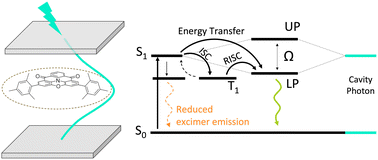2023-11-06 オーストラリア連邦研究会議(ARC)
◆新しいMR-TADF発光体が色純度と効率の向上を約束しましたが、高分子積載時の分子集合問題がありました。そこで、光学キャビティ内にMR-TADF分子を配置し、光と物質が相互作用する環境を作り出し、ポラリトンと呼ばれるハイブリッド粒子を形成し、これにより光放射を向上させました。この研究は、OLEDの性能向上に光学キャビティの潜在的な可能性を示し、視覚技術の未来に革新をもたらす可能性があります。
<関連情報>
- https://excitonscience.com/news/purer-colour-emission-through-strong-light-matter-coupling
- https://pubs.rsc.org/en/content/articlelanding/2023/TC/D3TC02133E
光共振器におけるマルチ共振TADF:低ポラリトン状態への効率的なエネルギー移動によるエキシマー放出の抑制 Multi-resonance TADF in optical cavities: suppressing excimer emission through efficient energy transfer to the lower polariton states
Inseong Cho, William J. Kendrick, Alexandra N. Stuart, Pria Ramkissoon, Kenneth P. Ghiggino, Wallace W. H. Wong and Girish Lakhwani
Journal of Materials Chemistry C Published03 Oct 2023
DOI:https://doi.org/10.1039/D3TC02133E
Abstract
Thermally activated delayed fluorescence (TADF) emitters suffer from molecular aggregation that limits their applicability in light emitting devices. Aggregation-induced excimer formation often leads to a larger Stokes shift, broader emission spectrum, and reduced emission quantum yields, limiting emitter dye loading to a few weight percent in organic light emitting devices. Here, we demonstrate suppression of excimer emission by dispersing a synthesised multi-resonance TADF emitter dye (OQAO(mes)2) in a PMMA host matrix and embedding the host–guest photoactive layer into an optical cavity. Rabi splitting up to 0.24 eV is obtained at 35 wt% dye loading. Under the strong coupling regime, prompt and delayed emission through excimer states is suppressed due to efficient energy transfer to the lower polariton (LP) states, demonstrated by the blue shift of the emission spectrum and narrowing of the emission linewidth. We also observe an increase in reverse intersystem crossing (RISC) rate constants up to 33% that we attribute to a decrease in activation energy by ≈2kT. This work highlights that strong light-matter interactions can be exploited to overcome aggregation-induced excimer losses providing a pathway towards efficient organic light-emitting diodes with high colour purity and organic semiconductor polariton lasing.




